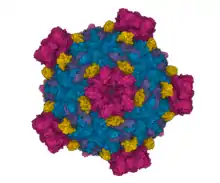Dinovernavirus
Dinovernavirus is a genus of double-stranded RNA viruses in the family Reoviridae and subfamily Spinareovirinae. Member viruses replicate in a variety of mosquito cell lines. The name is an abbreviation for double-stranded, insect, novem (Latin for nine the number of genome segments), rna virus. There is one species in the genus: the type species Aedes pseudoscutellaris reovirus.[1][2]
| Dinovernavirus | |
|---|---|
 | |
| Cryo-EM reconstruction of Fako virus capsid showing: turret protein (red), clamp protein (yellow), and homodimer of major capsid protein (blue/purple) | |
| Virus classification | |
| (unranked): | Virus |
| Realm: | Riboviria |
| Kingdom: | Orthornavirae |
| Phylum: | Duplornaviricota |
| Class: | Resentoviricetes |
| Order: | Reovirales |
| Family: | Reoviridae |
| Subfamily: | Spinareovirinae |
| Genus: | Dinovernavirus |
| Type species | |
| Aedes pseudoscutellaris reovirus | |
Structure
Viruses in Dinovernavirus are non-enveloped. Their capsid is turreted and single shelled with icosahedral geometries and T=2 symmetry. The diameter is around 49–50 nm.[1]
Genome
Genomes are linear and segmented. There are nine segments which code for nine proteins.[1]
Life cycle
Viral replication is cytoplasmic. Entry into the host cell is achieved by attachment to host receptors, which mediates endocytosis. Replication follows the double-stranded RNA virus replication model. Double-stranded RNA virus transcription is the method of transcription. The virus exits the host cell by monopartite non-tubule guided viral movement. Mosquito serve as the natural host.[1]
References
- "Viral Zone". ExPASy. Retrieved 13 August 2015.
- ICTV. "Virus Taxonomy: 2014 Release". Retrieved 13 August 2015.